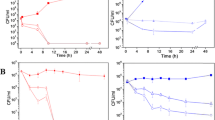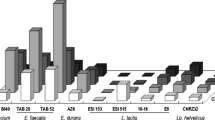Abstract
The bacteriocin production byEnterococcus faecium strain in cheese milk and cheese was demonstrated. Purified enterocin CCM 4231 exhibited an anti-listerial effect during Saint-Paulin cheese manufacture. During cheese production the strain grew to a final concentration of 10.1±0.01 log CFU per mL per g in cheese. Then only a slight decrease of the cell concentration was noticed during ripening and was almost stable for 8 weeks. No significant differences in pH were observed between the experimental and reference cheeses. Bacteriocin production during cheese manufacture was detected only in milk samples and curd, reaching a level of 100 AU/mL. After addition of purified enterocin CCM 4231 (concentration 3200 AU/mL) into the experimental cheese, the initial concentration of 6.7±0.06 log CFU per mL ofListeria monocytogenes Ohio was reduced up to 1.9±0.01 log CFU per mL per g. After 6 weeks and at the end of the experiment the difference of surviving cells ofL. monocytogenes Ohio in ECH was only one or 0.7 log cycle compared to the control cheese. Although enterocin CCM 4231 partially inhibitedL. monocytogenes in Saint-Paulin cheese manufacture, an inhibitory effect of enterocin added was shown in 1-week cheese; however, it was not possible to detect bacteriocin activity by the agar spot test. The traditional fermentation and ripening process was not disturbed, resulting in acceptable end-products, including sensory aspects.
Similar content being viewed by others
References
Davies E.A., Bevis H.E., Delves-Broughton J.: The use of the bacteriocin, nisin, as a preservative in ricotta-type cheeses to control the food-borne pathogenListeria monocytogenes.Lett. Appl. Microbiol. 24, 343–346 (1997)
De Vuyst L., Callewaert R., Pot B.: Characterization and antagonistic activity ofLactobacillus amylovorus DCE471 and large scale isolation of its bacteriocin amylovorin L471.Syst. Appl. Microbiol. 19, 9–20 (1996).
El-Ziney M.G., Debevere J.M.: The effect of reuterin onListeria monocytogenes andEscherichia coli O157:H7 in milk and cottage cheese.J. Food Protect. 61, 1275–1280 (1998).
Ennahar S., Sashira T., Sonomoto K., Ishizaki A.: Class lla bacteriocins: biosynthesis, structure and activity.FEMS Microbiol. Rev. 24, 85–106 (2000).
Farias M.E., Nunez De Kairuz M., Sesma F., Palacios J., De Ruiz Holgado A.P., Oliver G.: Inhibition ofListeria monocytogenes by the bacteriocin, enterocin RL35 during goat cheese making.Milchwissensch. 54, 30–32 (1999).
Ferreira M.A.S.S., Lund B.M.: The effect of nisin onListeria monocytogenes in culture medium and long-life cottage cheese.Lett. Appl. Microbiol. 22, 433–438 (1996).
Giraffa G.: Enterococcal bacteriocins: their potential as anti-Listeria factors in dairy technology.Food Microbiol. 25, 291–299 (1995).
Hanlin J.H., Evancho G.M.: The beneficial role of micro-organisms in the safety and stability of refrigerated foods, pp. 229–259 in C. Dennis, M. Stringer (Eds):Cilled Foods: a Comprehensive Guide. Ellis Horwood, New York 1994.
Holzapfel W.H., Geisen R., Schillinger U.: Biological preservation of foods with reference to protective cultures, bacteriocins and food-grade enzymes.Internat. J. Food Microbiol. 24, 343–362 (1995).
Kelly W.J., Asmundson R.V., Huang C.M.: Isolation and characterization of bacterion-producing lactic acid bacteria from readyto-eat food products.Internat. J. Food Microbiol. 33, 209–218 (1996).
Klaenhammer T.R.: Genetics of bacteriocins produced by lactic acid bacteria. FEMSMicrobiol. Rev. 12, 39–86 (1993).
Lauková A., Mareková M., Javorský P.: Detection and antimicrobial spectrum of a bacteriocin-like substance produced byEnterococcus faecium CCM 4231.Lett. Appl. Microbiol. 16, 257–260 (1993).
Lauková A., Czikková S., Burdová O.: Anti-staphylococcal effect of enterocin in Sunar® and yogurt.Folia Microbiol. 44, 707–711 (1999).
Lauková A., Czikková S., Dobránsky T., Burdová O.: Inhibition ofListeria monocytogenes andStaphylococcus aureus by enterocin CCM4231 in milk products.Food. Microbiol. 16, 93–99 (1999).
Lauková A., Juriš P., Vasilková Z., Papajová I.: Treatment of sanitary-important bacteria by bacteriocin substance V24 in cattle dung water.Lett. Appl. Microbiol. 30, 402–405 (2000).
Lauková A., Mareková M.: Production of bacteriocins by different enterococcal isolates.Folia Microbiol. 46, 49–52 (2001).
Mahadeo M., Tatini S.R.: The potential use of nisin to controlListeria monocytogenes in poultry.Lett. Appl. Microbiol. 18, 323–326 (1994).
McLaugchlin J.: Animal and human listeriosis: a shared problem?Vet. J. 153, 3–5 (1997).
Morovský M., Pristaš P., Javorský P.: Bacteriocins of ruminal bacteria.Folia Microbiol. 46, 61–62 (2001).
Nunez M., Ródriguéz J.L., Garcia E., Gaya P., Medina M.: Inhibition ofListeria monocytogenes by enterocin 4 during the manufacture and ripening of Manchego cheese.J. Appl. Microbiol. 83, 671–677 (1997).
Nes I.F., Diep D.B., Haverstein L.S., Brurberg M.B., Eijsink V., Holo H.: Biosynthesis of bacteriocins in lactic acid bacteria.Antonie van Leeuwenhoek 70, 113–128 (1996).
Scannell A.G.M., Hill C., Ross R.P., Marx S., Hartmeier W., Arendt E.K.: Development of bioactive food packing materials using immobilised bacteriocins lacticin 3147 and nisaplin.Internat. J. Food Microbiol. 60, 241–249 (2000).
Author information
Authors and Affiliations
Corresponding author
Rights and permissions
About this article
Cite this article
Lauková, A., Vlaemynck, G. & Czikková, S. Effect of enterocin CCM 4231 onListeria monocytogenes in Saint-Paulin cheese. Folia Microbiol 46, 157–160 (2001). https://doi.org/10.1007/BF02873596
Received:
Revised:
Issue Date:
DOI: https://doi.org/10.1007/BF02873596




